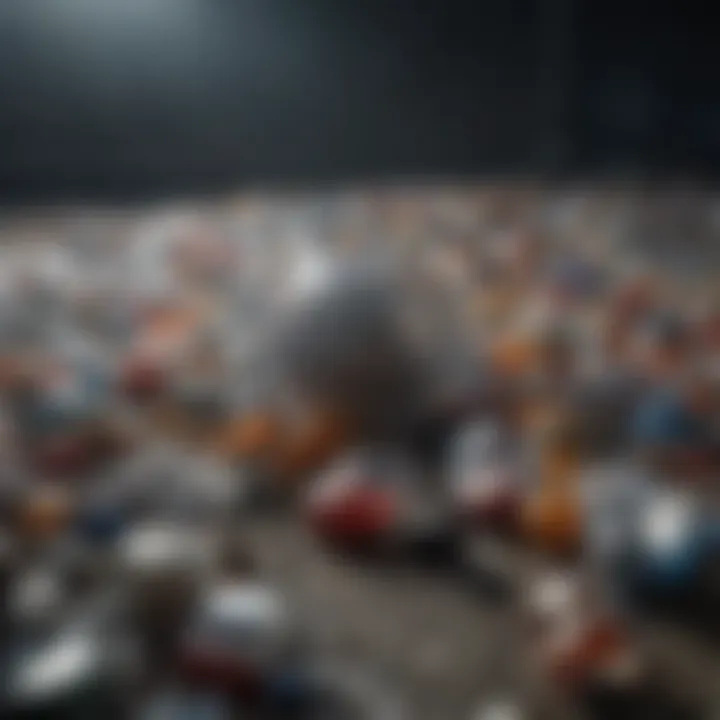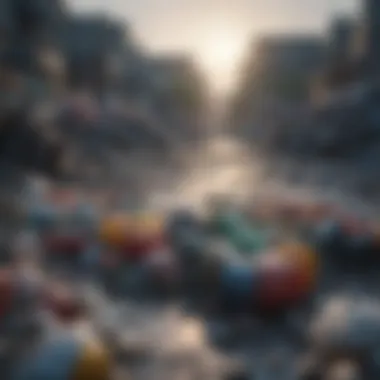Transforming Plastic Waste into Sustainable Fuel Solutions


Intro
In recent years, the issue of plastic waste has reached alarming proportions. Plastic pollution has become a critical environmental crisis that not only affects wildlife but also endangers human health. This growing dilemma has sparked innovative thinking about how to utilize this waste effectively. Of late, converting plastic waste into fuel has emerged as a promising avenue in tackling both waste management and energy production in a more sustainable manner.
The ingenuity behind transforming discarded materials into usable energy forms a fascinating intersection of science, technology, and environmentalism. As researchers and industries explore this area, the broader implications hint at a revolutionary shift in how society and economies can think about waste.
What's more, turning plastic into fuel not only holds the potential to mitigate pollution but also to create a renewable energy source. By converting non-biodegradable waste into something useful, we stand at the cusp of a significant change. This examination delves into the vital aspects of converting plastic waste into fuel, aiming to provide clarity about its methods, benefits, and challenges ahead.
Research Overview
Summary of Key Findings
In the realm of plastic waste conversion, several key findings have surfaced:
- Techniques of Conversion: Pyrolysis and gasification are the most explored methods, promising efficient conversion with potential energy yields comparable to fossil fuels.
- Economic Viability: Initial studies suggest that while investment in infrastructure is steep, the long-term benefits could outweigh costs through fuel production and environmental remediation.
- Environmental Impact: There is a potential to significantly reduce plastic waste in landfills, contributing to a cleaner environment.
- Regulatory Support: Emerging policies and regulations supporting alternative energy production could foster investment in this technology, facilitating wider adoption.
Relevance to Current Scientific Discussions
The mechanics of converting plastic waste into fuel touches upon multiple relevant scientific discussions today. At the core, it connects to:
- Circular Economy: This concept seeks to end waste and continuous resource usage, aligning perfectly with plastic-to-fuel methodologies.
- Renewable Energy: There is a constant dialogue about finding substitutes to fossil fuels, making this research pertinent for energy sectors.
- Waste Management Innovations: As landfills reach capacity, innovative waste solutions are crucial, reinforcing the importance of this research topic.
Understanding Plastic Waste
Plastic waste has become a pressing issue in our modern world, representing not just a product of consumption but also an environmental crisis. Understanding plastic waste is fundamental as it sets the stage for exploring solutions like converting it into fuel. This understanding begins with the different types of plastics found in waste streams today, and how each impacts our environment differently.
Types of Plastic Waste
Single-use plastics
Single-use plastics are often likened to fast food wrappers or coffee cups – designed for one-time use and then tossed away. The staggering reality is that these items dominate our landfills and oceans. Their key characteristic is their convenience, which drives rampant consumption. However, this very convenience is what makes them detrimental. One notable benefit in identifying single-use plastics is understanding that they are some of the most common contaminants in waste management systems, making their conversion to fuel crucial for reducing overall plastic pollution. Yet, the drawback is their often short lifespan, which leads to long-term environmental harm, as they can take hundreds of years to decompose.
Recyclable plastics
Recyclable plastics, including items marked with recycling symbols, hold a different promise. These plastics can be processed and reused, albeit the effectiveness of this process varies widely depending on the type of plastic and local recycling capabilities. The unique feature here is the potential for these plastics to re-enter the production chain, which can be an advantage over single-use options. In converting to fuel, recyclable plastics are typically more favored since they can lessen the environmental repercussions associated with disposal in landfills. However, a notable disadvantage is that not all recyclable plastics actually get recycled; often, they end up as waste due to contamination or lack of processing infrastructure.
Non-recyclable plastics
Non-recyclable plastics take quite the negative spotlight. Often made from complex materials that cannot be easily broken down or reused, their presence in the waste stream is troubling. Key aspects of non-recyclable plastics stem from their robustness and durability, making them widely used in packaging and industrial applications. Yet, this durability translates to longevity in the environment, contributing significantly to pollution. Converting non-recyclable plastics into fuel presents both an opportunity and a challenge. While they can be efficiently turned into energy, the disadvantage lies in the toxic byproducts that may arise during the conversion process, potentially offsetting some of the benefits.
Global Plastic Waste Statistics
Annual plastic production rates
The staggering statistics surrounding annual plastic production rates are eye-opening. Every year, the world produces millions of tons of plastic, with a significant portion ending up as waste. This figure is pivotal for understanding the sheer scale of the plastic waste crisis. High production rates encourage waste generation, which emphasizes the need for alternative solutions like plastic-to-fuel conversion. On the downside, this scale naturally leads to higher pollution levels unless we find ways to effectively mitigate the impacts, such as turning waste into energy.
Plastic waste accumulation in landfills
Plastic waste accumulation in landfills is an issue that can't be ignored; in fact, it's like watching a slow-moving disaster unfold. The unique pattern of plastic buildup is alarming, as landfills increasingly fill with items that will not biodegrade. This accumulation emphasizes the need for innovative solutions to deal with the waste effectively. Notably, a significant challenge derives from limited capacity in existing landfills, leading to overflow issues that complicate waste management strategies.
Oceanic pollution impacts
When we talk about oceanic pollution, it’s easy to picture images of wildlife entangled in plastic debris. This characteristic of plastic waste in oceans showcases the grave consequences for marine life and ecosystems. The widespread distribution of plastics in oceans highlights the global nature of the issue. The impacts are dire, affecting food chains and biodiversity. The unique aspect of oceanic pollution is its potential to accumulate microplastics, which can enter the human food chain, compounding health risks. Understanding these impacts is critical, as it underscores the urgency for effective conversion technologies to combat oceanic plastic waste.
"The fight against plastic pollution isn't just about cleaning up; it's about rethinking our relationship with plastic itself."
This overview of plastic waste illustrates why diving deep into converting waste into fuel is not merely beneficial but essential to addressing one of the most significant environmental challenges of our time. By understanding the nuances of plastic types and their waste statistics, we pave the way for discussions on technological innovations and environmental impacts that follow.
The Science of Plastic Conversion
Understanding the science behind converting plastic waste to fuel is pivotal in tackling one of the most pressing global issues: plastic pollution. This section explores various chemical and biochemical methods used in this transformation, shedding light on their processes, benefits, and challenges. The significance lies not only in their potential to alleviate waste but also in the opportunity they present for sustainable energy production.
Chemical Processes Involved
Pyrolysis
Pyrolysis is a thermal decomposition process that occurs in the absence of oxygen. This method breaks down complex plastics into simpler hydrocarbons, ultimately yielding a crude oil-like product. One of the standout features of pyrolysis is its ability to handle a diverse array of plastic types, including those that are typically considered unrecyclable. It’s popular due to its flexibility and relative efficiency.
The key characteristic of pyrolysis is its operational temperature, usually ranging between 300°C to 900°C. This high temperature is crucial for ensuring that the plastics fully break down into smaller molecules. The product, which includes liquid oils, gases, and char, can be further refined into usable fuels. However, it’s worth mentioning that pyrolysis plants require significant upfront investment and operational costs, which can deter potential investors.


"Pyrolysis can serve as a bridge between waste management and energy production, acting as both a solution for plastic waste and a source of renewable fuel."
Gasification
Gasification differs from pyrolysis in that it utilizes a limited amount of oxygen or steam during the conversion process. This method converts carbonaceous materials into syngas, a mixture primarily composed of hydrogen and carbon monoxide. The unique aspect of gasification is its ability to generate a cleaner gas output, which can be directly used in energy production or further processed into liquid fuels.
One primary advantage of gasification is its adaptability to a broader range of feedstocks, not just plastics. This flexibility can make it more appealing as industries increasingly turn to varied waste streams. However, the technology is relatively complex, requiring advanced reactor designs and rigorous monitoring to ensure operational efficiency and safety.
Hydrogenation
Hydrogenation is another interesting method that uses hydrogen to convert plastic waste into liquid hydrocarbons. This approach usually follows the gasification process that produces syngas, which is then reacted with hydrogen in the presence of a catalyst. The ability of hydrogenation to produce high-quality, stable fuels makes it a highly attractive option.
The high yield of liquid fuels per unit of waste can significantly contribute to energy recovery from plastic waste. However, the reliance on hydrogen as a reactant raises economic and logistical considerations, as hydrogen production can be energy-intensive. Additionally, sourcing green hydrogen contributes positively to sustainability goals but remains a challenge due to current production methods.
Biochemical Methods
Enzymatic Degradation
Enzymatic degradation is a promising biochemical approach involving specific enzymes that can break down polymers into monomers. This method stands out due to its environmentally friendly nature, as it operates under mild conditions and doesn’t produce harmful byproducts. The key characteristic of this method is its specificity; certain enzymes target particular plastics like PET and polystyrene.
The advantages of enzymatic degradation include low energy consumption and minimized carbon footprint. Nonetheless, the technology is still under research, and scale-up processes remain a significant challenge. There are concerns regarding the efficiency and cost-effectiveness of producing enzymes in large quantities needed for industrial applications.
Microbial Fermentation
Microbial fermentation utilizes specific microorganisms to convert plastic waste into biofuels. One remarkable aspect of this method is the potential for microbes to consume plastic waste as their primary food source. Certain bacteria can thrive on plastic and produce valuable byproducts such as biogas, which can be harnessed for energy.
While microbial fermentation is considered eco-friendly and holds potential for low-cost processing, it faces several challenges. The primary drawback is the slower reaction speed compared to chemical methods, which might not meet the commercial demand in the short term. Nonetheless, ongoing research promises to enhance efficiency and expand the range of plastics that can be targeted.
In summary, both chemical and biochemical methods present exciting avenues for converting plastic waste into fuel, each with its own set of advantages and limitations. Understanding these methodologies is crucial for informing future research and policy decisions aimed at mitigating plastic pollution and promoting sustainable energy solutions.
Technological Innovations
The landscape of converting plastic waste into fuel is rapidly evolving with the help of various technological innovations. These advancements not only streamline the conversion processes but also enhance the overall effectiveness and sustainability of plastic waste management strategies. As we dig deeper into this section, we will highlight the importance, the uniqueness, and the potential drawbacks of current technologies, small-scale solutions, and emerging technologies in this vast field.
Current Technologies
Industrial applications
When we talk about industrial applications, we're diving into the backbone of large-scale plastic conversion operations. These setups employ sophisticated machinery and chemical processes to ensure efficient transformation of plastic into usable fuel. A key characteristic of industrial applications is their capacity to handle vast volumes of plastic waste. This makes them a beneficial choice for industries seeking to contribute meaningfully to waste reduction and energy recovery.
One unique feature of these applications is their ability to scale up operations and integrate with existing waste management systems. For example, facilities designed for pyrolysis or gasification can perform continuous processing, allowing for a more sustainable approach. However, despite the clear advantages, these industrial setups entail significant initial investments and compliance with various regulations, which can pose challenges for some companies.
Small-scale solutions
Small-scale solutions are becoming increasingly relevant, especially among communities and startups tackling local plastic waste issues. These technologies, often designed for easier operation and lower capital costs, contribute significantly to the overall goal of sustainable waste management. A notable characteristic of small-scale solutions is their accessibility. Many of them can be easily constructed and operated with minimal technical expertise, which makes them attractive choices for smaller enterprises or entrepreneurial endeavors.
Unique features of these systems include modular designs. They allow users to manage smaller quantities of waste effectively without the hefty overhead of larger industrial plants. But on the flip side, these solutions often produce less fuel compared to their larger counterparts, sometimes limiting their economic viability in some areas.
Emerging technologies
The field of converting plastic waste is witnessing promising breakthroughs with emerging technologies. Innovations such as advanced catalysts, enhanced pyrolysis methods, and bioengineering approaches are at the forefront of this evolution. The key characteristic of these technologies lies in their potential to overshadow traditional methods by improving efficiency and yielding better-quality fuel.
One unique feature is their capacity to integrate biotechnological advancements, like utilizing enzymes or microbes that can break down plastics more efficiently. Such integration could transform how we perceive plastic waste, shifting from viewing it merely as trash to embracing it as a valuable resource. However, the development of these technologies often comes with uncertainties regarding scalability and implementation costs, challenging the transition from laboratory to real-world applications.
Future Trends in Conversion Technology
Integration with renewable energy sources
The future of plastic-to-fuel technology is promising, especially concerning integration with renewable energy sources. Merging these two elements can contribute to a more sustainable energy landscape. By employing renewable energy to power conversion processes, companies can reduce their carbon footprints and enhance operational sustainability. This is a compelling choice for organizations that prioritize eco-friendly practices.
A unique feature of this integration is the potential to create a closed-loop system, where waste-derived fuel is produced using energy sourced from sustainable methods, creating synergy. However, the challenges lie in the initial capital required to set up such integrated systems, which can be a barrier for some businesses looking to adopt these practices smoothly.
Advancements in catalysis
Advancements in catalysis are perhaps one of the most critical areas to watch as they hold the key to making conversion processes more efficient. Developing new catalysts can enable processes to occur at lower temperatures and with faster reaction rates, influencing the economics of plastic-to-fuel technologies significantly. This feature has made it a favorable avenue for researchers exploring cost-effective solutions for large-scale adoption.
One unique aspect of these advancements is their potential for specialized applications. For instance, certain catalysts may target specific types of plastics, yielding better fuel quality from challenging waste inputs. Nonetheless, the complexity in designing effective catalysts and understanding their long-term stability remains a concern that researchers need to tackle.
"Technological innovations in plastic waste conversion not only aim for efficiency but also pave the way for a future where waste is viewed not just as refuse but as a resource."


In summation, the exploration of technological innovations in converting plastic waste into fuel reveals a diverse and dynamic landscape. With industrial scale applications promising efficiency and small-scale solutions addressing local needs, the future trends hold significant potential for integration with renewable energies and advancements in catalysis that push the envelope of what's possible in this crucial sector.
Environmental Impact
The impact of plastic waste on our environment is monumental, and understanding it is crucial for exploring the conversion of that waste into fuel. In the recent years, more attention has been paid to the ramifications of our ever-increasing reliance on plastic. As we delve deeper into this topic, it is vital to look at how converting plastic waste into fuel can serve as not just a remedy but as a stepping stone toward a more sustainable future.
Benefits of Plastic-to-Fuel Conversion
Reduction of plastic waste
Converting plastic waste into fuel can play a significant role in reducing the staggering amounts of waste piling up in landfills and oceans. With millions of tons of plastic discarded every year, finding effective means of disposal is paramount. This method stands out primarily because it transforms problematic materials into a usable resource. As plastic is incinerated or buried, those methods often lead to more environmental harm than good. The unique feature here is the potential for transforming waste into a valuable output—fuel—helping to lessen the burden on our planet. Thus, this method becomes an even more attractive option, considering the sheer scale of plastic littering our ecosystems.
Lower carbon emissions
Another notable benefit is the decrease in carbon emissions associated with traditional waste management. Converting plastic to fuel can result in lower emissions compared to incineration or landfill operations, which often release harmful gases. This fuel conversion process can lead to a more efficient extraction of energy from waste, emphasizing a critical aspect of modern energy solutions. While it doesn't eliminate emissions entirely, it does make the process relatively cleaner, which is a crucial step towards cleaner energy sources. The intriguing part about this method is the overall potential to shift energy models towards more sustainable routes.
Energy recovery
One of the most compelling aspects of converting plastic waste to fuel is the concept of energy recovery. Not only does this process help in waste reduction, but it also taps into the energy present in plastics, which otherwise would go to waste. This energy can then be harnessed to produce heat, electricity, or transportation fuels, aligning perfectly with current demands for diverse energy needs. Particularly noteworthy is the adaptability of this process, as it can easily be integrated into existing fuel systems, providing a bridge to more sustainable fuel solutions. Such recovery efforts present an opportunity to develop new energy paradigms while managing common waste issues efficiently.
Challenges and Concerns
Toxic byproducts
Despite the promising benefits, there are significant challenges to consider, such as the generation of toxic byproducts during conversion processes. Some methods have been known to release pollutants that can have severe environmental impacts. Addressing these byproducts is crucial to make the practice not just effective, but safe. The need for strict monitoring and management is evident here. If left unattended, even the most innovative solutions can backfire, compromising their intended environmental benefits.
Energy consumption in conversion
Energy consumption during the conversion process presents another hurdle. It's a bit of a catch-22; while converting plastic to fuel can help in recovery, the conversion methods require energy themselves. Evaluating the carbon footprint of the entire process becomes essential. One must assess whether the energy required during conversion outweighs the benefits gained afterward. This presents a crucial consideration for investors and policymakers. It's essential to strike a balance between the energy input and the sustainable output generated.
Public perception and misconceptions
Lastly, public perception plays a vital role in future developments. There appears to be a misunderstanding surrounding the effectiveness and safety of converting plastic to fuel. Some folks might consider it a "quick fix" rather than a long-term solution, leading to skepticism in adopting such technologies. Shift in public attitude will depend on clearer communication about the processes involved and their benefits. Engaging communities and raising awareness is necessary to dispel myths and promote responsible practices.
Converting plastic waste to fuel presents an opportunity to tackle two problems: plastic pollution and energy demands. However, clear communication and responsible practices are vital in making this a success.
Market Dynamics
Understanding market dynamics in the context of converting plastic waste to fuel is crucial for grasping the potential impact this industry can have on the economy and environment. The current landscape is defined by various forces such as supply and demand, price fluctuation, and the competitive landscape, all of which play a vital role in determining the feasibility of this transformative process.
Economic Viability
Cost-benefit analysis
A cost-benefit analysis serves as a foundational tool in evaluating the financial implications of converting plastic waste to fuel. This analysis weighs the possible costs—such as the expenses involved in technology development and installation—against the benefits, including the potential income from selling fuel generated from waste.
One main characteristic of this type of analysis is its ability to provide a clear picture of the return on investment. For industries grappling with the high costs of recycling and waste management, a favorable cost-benefit analysis can be a game-changer. It indicates whether the conversion process can not only pay for itself but also contribute positively to the bottom line.
What's unique about a cost-benefit analysis in this context is the multifaceted nature of the evaluation, which can include socio-environmental benefits. For instance, the reduction of landfill usage and the associated environmental costs can also factor into the analysis, pushing it to the side of financial viability. However, it's important to acknowledge potential disadvantages, such as the reliability of data used or unanticipated costs that could arise during the conversion process.
Investment trends
Investment trends showcase how financial interests are evolving in this burgeoning sector. As society becomes more aware of the environmental crises caused by plastic waste, investments have surged in technologies that convert waste into fuel. Investors are increasingly interested in backing companies that demonstrate promising technologies or business models.
A key characteristic of these investments is their alignment with global sustainability goals. Many venture capital firms are seeking to put their money into eco-friendly innovations, viewing them as both profitable and responsible. Unique features include partnerships with governmental bodies or NGOs that often provide much-needed capital and resources, demonstrating that this trend is not merely a passing fad, but a well-thought-out strategy for both profit and progress.
While investment in this area is promising, it does come with its challenges. Investors need to carefully consider the risks associated with emerging technologies and fluctuating market dynamics. The volatile market for oil, on which these technologies often depend, can also impact investment returns negatively.
Potential for Commercial Growth
Market demand for alternative fuels
The market demand for alternative fuels has dramatically risen in recent years, reflecting a broader shift towards sustainable energy sources. This growing demand is an essential driving force behind the conversion of plastic waste to fuel. Consumers, along with governments, are increasingly leaning towards solutions that lower dependency on fossil fuels and minimize environmental impact.
One of the defining characteristics of this demand is its urgency. Many countries have set ambitious targets regarding carbon neutrality and are actively searching for innovative solutions to meet these goals. A significant feature of this market demand is its informed nature—consumers are now educated and vigilant about the environmental practices of the brands they support. As such, businesses that pivot towards sustainable practices gain a competitive edge.
On the flip side, while market demand is promising, it must navigate a landscape filled with other energy options, like solar, wind, and biomass. Companies venturing into converting plastic waste must differentiate their products while keeping an eye on consumer preferences, which might shift over time.
Role of government incentives


Government incentives play a pivotal role in shaping the market for converting plastic waste to fuel. These incentives can take the form of grants, tax breaks, or even research funding aimed at fostering innovation in sustainable technologies. The primary effect of such incentives tends to lower the financial barriers that startups and companies face when developing their technologies.
A notable characteristic of these incentives is their ability to catalyze investor interest. With governmental support, investors might feel more confident taking risks, knowing the infrastructure and policy frameworks are favorable for long-term success. The unique feature of these incentives is that they not only promote growth in the private sector but also align public policy with broader sustainability goals.
Nevertheless, reliance on government incentives does present some risks. Changes in political will, regulatory shifts, or budget constraints can affect the availability and scope of such incentives, complicating the planning of businesses within this sector. A careful balance is necessary to ensure that while incentives spur growth, they don't create a dependency on government support.
Regulatory Framework
The regulatory framework surrounding the conversion of plastic waste to fuel plays a crucial role in ensuring the process is efficient, safe, and sustainable. Regulations not only establish standards but also define the responsibilities of various stakeholders, from manufacturers to consumers. This section digs into the international regulations and national policies that shape this burgeoning field, highlighting how these align with broader environmental goals and facilitate advancements in technology.
International Regulations
Global agreements on plastic waste
One key aspect of global agreements on plastic waste is their commitment to reducing plastic pollution across borders. Notable agreements, like the Basel Convention, focus on controlling the transboundary movement of hazardous waste and promoting environmentally sound disposal of plastics. These agreements help foster international cooperation and create shared standards among member countries. Such collaboration is beneficial as it promotes a uniform approach that can streamline the processes involved in converting plastic waste into fuel. The unique feature here is that these agreements not only set guidelines but also encourage countries to develop their own, tailored solutions based on local needs and practices.
Key characteristics of these agreements include the ability to set legally binding targets and mechanisms to ensure accountability among nations. Though they have notable benefits in terms of fostering collaboration, they also present challenges, such as varying levels of commitment and enforcement among nations, which can lead to inconsistencies in how waste is managed globally.
Standards for fuel quality
Standards for fuel quality are also essential in ensuring that the end products derived from plastic conversion processes are safe, efficient, and environmentally friendly. These standards, often set by organizations like the International Organization for Standardization (ISO), ensure that fuels produced meet specific criteria regarding emissions and composition. A key characteristic here is the emphasis on performance benchmarks that help both manufacturers and consumers gauge the effectiveness of the fuel derived from plastics.
The notable advantage of having these standards is the assurance they provide to consumers regarding the quality of the products they use. However, they also introduce complexity to the industry. Companies must ensure their processes align with these standards, which can require substantial investment in technology and training. The advantage lies in the potential for increased market acceptance and demand for fuels derived from plastic waste, which can ultimately drive innovation in the industry.
National Policies
Regulatory challenges
In the context of national policies, regulatory challenges represent significant hurdles that can impede the efficient conversion of plastic waste to fuel. Regulatory frameworks might lack clarity, leading to uncertainty for businesses trying to navigate the landscape. A significant characteristic of these challenges is their variability; rules can differ not only from country to country but also within regions of the same country. This may result in a patchwork of regulations that complicate compliance efforts for companies.
These challenges can dissuade investment in new technologies and methods for plastic conversion, creating a bottleneck in innovation. While it is certainly a challenge, it also presents an opportunity for advocates to push for streamlined and coherent regulations that can help elevate the entire industry.
Support for research and development
Support for research and development in this field is vital for driving forward the technologies required to convert plastic waste effectively into fuel. Government policies that favor innovation can lead to groundbreaking advances that make conversion processes more efficient and economically feasible. A hallmark of such support is the funding and resources provided to universities and research organizations that explore novel methods and strategies.
Generating robust policies not only strengthens the sustainability of plastics management but also positions the country as a leader in the green technology sector. The unique feature of bolstered research funding is its potential to yield results that can be commercially viable, advancing the entire industry. However, the challenge remains in ensuring that these investments are sustained rather than one-off injections of cash, which can lead to inconsistencies in research continuity and impact.
Future Implications
Long-term Sustainability
Toward a circular economy
A circular economy offers a fresh perspective on waste management, particularly when it comes to plastic. It encourages us to rethink how we create, use, and dispose of materials. Instead of the traditional linear model—produce, use, throw away—the circular approach aims to keep resources in use for as long as possible. This characteristic is especially crucial for tackling plastic waste, which takes centuries to decompose in landfills.
Key features of a circular economy include reusing, refurbishing, and recycling materials. By implementing these strategies, we can significantly reduce the volume of plastic that finds its way to landfill or ocean. This decision will not just alleviate environmental stress; it's also a sound economic move as materials can be recovered and reintegrated back into production processes.
The unique advantage here is the alignment with sustainability goals while retaining economic benefits.
However, there are challenges, such as the existing industrial infrastructure that is primarily designed for linear processes. Transitioning to a circular economy requires a significant shift in mindset and policy. Yet, once achieved, the long-term benefits far outweigh the initial hurdles.
Impacts on fossil fuel dependency
Moving towards alternatives like plastic waste-to-fuel conversion can significantly dampen our reliance on fossil fuels. This reduction is a pivotal aspect of the global effort to mitigate climate change. By utilizing plastic waste as a fuel source, we overshadow some of the harmful environmental impacts linked with crude oil extraction and consumption. This switch can not only lessen the demand for fossil fuels but also create a more resilient energy framework that amplifies sustainability.
A notable characteristic of this change is its dual impact: it tackles plastic pollution while contributing to energy supplies. It echoes the idea that waste can serve a purpose, transforming environmental liabilities into valuable assets. Plus, it potentially stabilizes fuel prices by diversifying the energy sources available.
However, one mustn’t overlook the intricacies. The processes involved are still energy-intensive and come with their own set of emissions. That said, with innovation and stringent regulatory frameworks, these concerns can be managed.
Consumer Awareness and Engagement
Education on plastic waste issues
Education holds the power to reshape public perception and behavior towards plastic waste. When we raise awareness about the ramifications of plastic use—especially when combined with research on conversion technologies—we create a more informed consumer base. People who understand the full impact of plastic waste are more likely to support related innovations and policies.
A defining characteristic of educational initiatives is their layered approach: they address not only the environmental challenges but also the technological advancements that aim to solve them. This connection makes education a popular choice, as it blends knowledge with actionable insights.
A key benefit of this educational approach is fostering community involvement in sustainability efforts. Engaged consumers can drive change, demanding more from companies and advocating for innovative solutions. However, the challenge lies in ensuring that information is accessible and relatable. Without this, even the best-informed consumers might struggle to translate knowledge into responsible behaviors.
Encouraging responsible consumption
Promoting responsible consumption is crucial in the conversation about plastic waste and fuel conversion. This strategy involves urging consumers to rethink their purchasing habits and the lifecycle of the products they buy. By instilling a mindset where individuals consider the impact of their choices, we can cultivate a culture that prioritizes sustainability.
A key trait of this initiative is that it emphasizes personal responsibility and collective impact. When many individuals make incremental changes, the cumulative effect can be substantial. This makes it a beneficial strategy in the narrative of sustainability.
Yet, the road to changing consumption habits is often dotted with challenges. Not everyone has access to sustainable options or is aware of the implications of their actions. Thus, incorporating social equity considerations into these efforts is essential. Achieving responsible consumption as a norm rather than an exception will take time, but it is a worthwhile endeavor in the journey towards a sustainable future.



